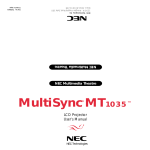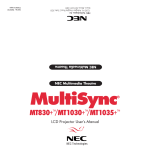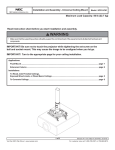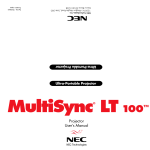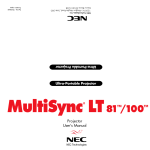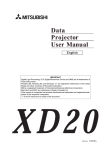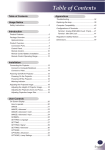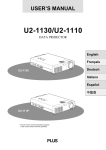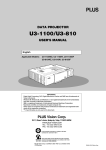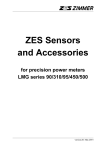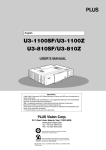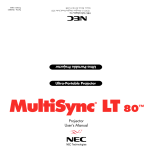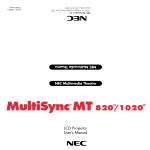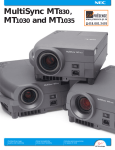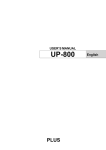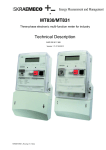Download - NEC Display Solutions Europe
Transcript
LCD PROJECTOR
MultiSync MT830/1030
USER'S MANUAL
English
Deutsch
Françe
Español
Italiano
Svenska
MultiSync MT830/MT1030
LCD Projector
User’s Manual
English
IMPORTANT INFORMATION
Precautions
Important Safeguards
Please read this manual carefully before using your NEC
MultiSync MT830/1030 LCD Projector and keep the manual
handy for future reference.
These safety instructions are to ensure the long life of your LCD
projector and to prevent fire and shock. Please read them carefully and
heed all warnings.
Your serial number is located under the name plate label on the right
side of your MultiSync MT830/1030 . Record it here:
Installation
1. For best results, use your LCD projector in a darkened room.
2. Place the projector on a flat, level surface in a dry area away from dust
and moisture.
CAUTION
3. Do not place your LCD projector in direct sunlight, near heaters or
heat radiating appliances.
LASER RADIATIONDO NOT STARE INTO BEAM
4. Exposure to direct sunlight, smoke or steam can harm internal
components.
5. Handle your LCD projector carefully. Dropping or jarring can damage internal components.
WAVE LENGTH: 645 nm (640-660 nm)
MAX. OUTPUT: 1 mW
CLASS II LASER PRODUCT
6. Do not place heavy objects on top of the LCD projector.
7. If installing the LCD projector on the ceiling:
a. The ceiling must be strong enough to support the LCD projector
and the installation must be in accordance with any local building codes.
WARNING
TO PREVENT FIRE OR SHOCK, DO NOT EXPOSE THIS
UNIT TO RAIN OR MOISTURE. DO NOT USE THIS
UNIT’S GROUNDED PLUG WITH AN EXTENSION
CORD OR IN AN OUTLET UNLESS ALL THREE
PRONGS CAN BE FULLY INSERTED. DO NOT OPEN
THE CABINET. THERE ARE HIGH-VOLTAGE COMPONENTS INSIDE. ALL SERVICING MUST BE DONE BY
QUALIFIED NEC SERVICE PERSONNEL.
b. The LCD projector must be installed by qualified NEC service
personnel.
Power Supply
1. The LCD projector is designed to operate on a power supply of 100120 or 220-240 V 50/60 Hz AC. Ensure that your power supply fits
this requirement before attempting to use your LCD projector.
CAUTION
2. Handle the power cable carefully and avoid excessive bending. A
damaged cord can cause electric shock or fire.
To turn off main power, be sure to remove the plug
from power outlet. The power outlet socket should be
installed as near to the equipment as possible, and should
be easily accessible.
3. If the LCD projector is not to be used for an extended period of time,
disconnect the plug from the power outlet.
Cleaning
1. Unplug the LCD projector before cleaning.
2. Clean the cabinet periodically with a damp cloth. If heavily soiled,
use a mild detergent. Never use strong detergents or solvents such as
alcohol or thinner.
3. Use a blower or lens paper to clean the lens, and be careful not to
scratch or mar the lens.
4. Clean the air filter with a vacuum cleaner after every 100 hours of
operation.
a. Clean the outside of the filter with a vacuum cleaner.
b. Do not use water or any other liquid to clean the air filter.
c. Do not operate your LCD projector without the air filter.
CAUTION
TO PREVENT SHOCK, DO NOT OPEN THE
CABINET. NO USER-SERVICEABLE PARTS
INSIDE. REFER SERVICING TO QUALIFIED
NEC SERVICE PERSONNEL.
This symbol warns the user that uninsulated
voltage within the unit may be sufficient to
cause electrical shock. Therefore, it is dangerous to make any kind of contact with any
part inside of the unit.
This symbol alerts the user that important
information concerning the operation and
maintenance of this unit has been provided.
The information should be read carefully to
avoid problems.
3. GSGV Acoustic Noise Information Ordinance:
The sound pressure level is less than 70 dB(A) according to ISO 3744 or
ISO 7779.
E-2
Lamp Replacement
• Perform lamp replacement in accordance with the instructions on
page E-37.
• Be sure to replace the lamp when the Status light comes on. If you
continue to use the lamp after 2000 hours of use, the lamp bulb may
shatter, and pieces of glass may be scattered in the lamp case. Do not
touch them as the pieces of glass may cause injury. If this happens,
contact your NEC dealer for lamp replacement.
• Allow a minimum of ONE minute to elapse between turning the lamp
off and on. High voltage is applied to the lamp immediately when the
power is turned on. Therefore turning the power off and quickly back
on may shorten the life of your lamp and result in damage to your
LCD projector.
Fire and Shock Precautions
1. Ensure that there is sufficient ventilation and that vents are unobstructed to prevent the build-up of heat inside your LCD projector.
Allow at least 3 inches (10cm) of space between your LCD projector
and a wall.
2. Prevent foreign objects such as paper clips and bits of paper from
falling into your LCD projector. Do not attempt to retrieve any objects
that might fall into your projector. Do not insert any metal objects
such as a wire or screwdriver into your LCD project. If something
should fall into your projector, disconnect it immediately and have the
object removed by a qualified NEC service person.
3. Do not place any liquids on top of your LCD projector.
• Do not look into the lens while the projector is on.
Serious damage to your eyes could result.
• Do not look into the laser pointer while it is on and do
not point the laser beam at another person. Serious
injury could result.
E-3
TABLE OF CONTENTS
1. Introduction
Introduction To The MultiSync MT830/1030 LCD Projector ....................................... E-5
How Do You Get Started ? ............................................................................................ E-6
What’s In The Box? ...................................................................................................... E-6
Getting To Know Your MultiSync MT830/1030 LCD Projector ................................... E-7
Front / Rear Features .............................................................................................. E-7
Side Features ......................................................................................................... E-7
Top Features .......................................................................................................... E-8
Terminal Panel Features ......................................................................................... E-9
Remote Control Features ..................................................................................... E-11
2. Installation
Setting Up Your MultiSync MT830/1030 LCD Projector ........................................... E-14
Selecting A Location ............................................................................................ E-14
Using A Tabletop Or Cart .................................................................................... E-15
Ceiling Installation ............................................................................................... E-18
Reflecting The Image ........................................................................................... E-20
Rear Screen Projection ......................................................................................... E-20
Wiring Diagram .......................................................................................................... E-21
Connecting Your PC Or Macintosh Computer ............................................................ E-22
Connecting Your Document Camera ........................................................................... E-25
Connecting Your VCR Or Laser Disc Player ............................................................... E-25
Connecting An External Monitor ................................................................................ E-25
Connecting Your Computer To The Mouse Output Port .............................................. E-25
3. Operation
General Controls ......................................................................................................... E-26
Using The Menus ........................................................................................................ E-27
Menu Descriptions & Functions ................................................................................. E-28
Source Menu (Source Icons) ................................................................................ E-28
Image Adjust Menu(Sound And Picture Control Icons) ....................................... E-29
Power Menu(Projector Control Icons) ................................................................. E-31
Settings Menu(Maintenance Icons) ...................................................................... E-32
Using the Viewer function .................................................................................... E-33
4. Maintenance
Replacing The Lamp ................................................................................................... E-37
Cleaning Or Replacing The Filter ............................................................................... E-38
Remote Control Battery Installation ............................................................................ E-38
5. Troubleshooting
Status Light Messages ................................................................................................. E-39
Common Problems & Solutions .................................................................................. E-40
6. Specifications
Optical ........................................................................................................................ E-41
Electrical ..................................................................................................................... E-41
Mechanical ................................................................................................................. E-41
D-Sub Pin Assignments .............................................................................................. E-43
Timing Chart ............................................................................................................... E-44
PC Control Command Reference ................................................................................ E-45
Cable Connection ........................................................................................................ E-46
E-4
1 INTRODUCTION
•
An image can be projected from in front or behind a
screen, and the projector can even be installed on the
ceiling.
• NEC Technologies' exclusive AccuBlend intelligent pixel
blending technology - an extremely accurate image compression technology - offers a crisp image with SXGA
(128021024) resolution*3. You can select any point on
the screen with the pointer and enlarge the selected area.
• Supports most IBM VGA, SVGA, XGA, SXGA(with
AccuBlend)*3, Macintosh, or any other RGB signals within a
horizontal frequency range of 15.625 to 85 kHz and a vertical
frequency range of 50 to 85 Hz. This includes NTSC, PAL,
SECAM and NTSC4.43 standard video signals.
This section introduces you to your new MultiSync MT830
(SVGA) / 1030 (XGA) LCD Projector, provides a list of
materials that comes with your projector and describes the
features and controls.
Congratulations On Your Purchase Of The
MultiSync
MT830/1030 LCD Projector
The MultiSync MT830/1030 is one of the very best LCD
projectors available today. The multiple LCD panels enable
you to project precise images up to 300 inches (762 cm)
across (measured diagonally) from your PC or Macintosh
computer (desktop or notebook), VCR, DVD player, document camera, or even a laser disc player.
Note: Composite video standards are as follows:
NTSC:
U.S. TV standard for video in U.S. and Canada.
PAL:
TV standard used in western Europe.
SECAM: TV standard used in France and Eastern Europe.
NTSC4.43: TV standard used in Middle East countries.
You can use the projector on a tabletop or cart, you can
permanently mount it on a ceiling* 1 , or you can use
MultiSync MT830/1030 LCD Projector to project images
from behind the screen. The remote control can be used
wirelessly or with a cable, and you can even use the remote
control with the built-in remote mouse receiver to operate the
mouse on your PC or Mac. But best of all, the MultiSync
MT830/1030 is an NEC LCD projector. That means you can
depend on years of reliable performance and crystal-clear
presentations!
•
The remote control can be used with or without a cable,
and you can even use the remote to operate your PC or
Macintosh mouse wirelessly from across the room with
the built-in remote mouse receiver.
• You can control your MultiSync MT830/1030 LCD Projector with a PC.
• The contemporary cabinet design is compact, easy to
carry, and complements any office, board room or auditorium.
• Eight kinds of pointers are available for your presentation.
Features you’ll enjoy:
• Simple set up and operation.
• Hot air blown from the vents does not bother the audience
during your presentation since the vents are located on the
front.
• A high-performance 150 watt short arc high pressure lamp
that delivers 1000 ANSI lumens (MT1030: 900 ANSI
lumens) and an operating lamp life is 2000 hours.
• A wireless remote control that operates the projector from
any angle.
• A laser pointer that' s built into the remote control.
• The power zoom control enables you to adjust the image
to be between 50.8 and 762 cm (measured diagonally).
• Keystone correction allows you to correct trapezoidal distortion so that the image is square.
• White balance control allows you to adjust the brightness
and contrast for each RGB color.
• You can choose between video modes depending on your
source: "normal" for a typical picture, "natural" for true
color reproduction, and "camera" for use with a document
camera or low APL picture.
• The optional MT Viewer kit allows you to start your
presentation even when a PC is not available at the site.
• The "image capture" enables you to use the entire picture
as a background image or to create slides (optional MT
Viewer required).
*1 Installing the MultiSync MT830/1030 LCD Projector on
the ceiling must be done by authorized NEC technicians.
Consult your NEC dealer for more information.
*2 An XGA image (10242768) is converted into an
8002600 crisp image with NEC technology's AccuBlend.
*3 An SXGA image (128021024) is converted into a
10242768 crisp image with NEC technology's
AccuBlend.
E-5
How Do You Get Started?
Remote control
String and rivet
The fastest way to get started is to take your time and do
everything right the first time. Take a few minutes now to review
the manual. This may save you hours later on. At the beginning
of each section of the manual you'll find an overview. If the
section doesn't apply, you can skip it.
What’s In The Box?
Make sure your box contains everything listed. If any pieces are
missing, contact your dealer. Please save the original box and
packing materials if you ever need to ship your MultiSync MT830/
1030 LCD Projector.
•
•
•
•
•
•
•
•
•
•
Batteries (AA22)
NEC MultiSync MT830/1030 LCD Projector
Remote Control With Built-In Laser Pointer And Cables
Mouse Adapter for IBM PS/2 and Mac
Serial Cable
Signal Cable (15-Pin Mini D-Sub To 15-Pin Mini D-Sub Connector)
Pin Adapter for Macintosh
Power Cable
Two AA Batteries
User’s Manual
String and Rivet
Mouse adapter (For IBM PS/2)
Pin adapter for
Remote cable
Macintosh
Mouse adapter (For Macintosh)
Signal cable
Power cable
(15-Pin Mini D-Sub To 15-Pin Mini D-Sub connector)
Serial cable
User’s manual
U
Maser's
nu
al
E-6
Getting To Know Your MultiSync
MT830/1030 LCD Projector
Front Features
AC Input
Plug the female end of the supplied
power cable here, and the male end
into a properly grounded outlet.
Lens And Lens Cap
Remote Sensor
Main Power Switch
Carrying Handle
Rear Features
Remote Sensor
Built-In Speaker
(2W)
Built-In Speaker
(2W)
AC IN
One-Touch
Tilt button
Front Vent Slot for Kensington
MicroSaver Security System
One-Touch
Tilt button
Rear Feet
Front Feet
Right Side Features
Left Side Features
Connector Cap
Lamp Cover
Remote Sensor
Lamp Cover Set Screw
Carrying Handle
Remote Sensor
S–VIDEO INPUT
PC CONTROL MOUSE OUTPUT
AUDIO
RGB MONITOR OUTPUT
L/MONO
RGB
L/MONO
VIDEO
Filter Cover
Slot Cover for the Optional
MT Viewer Board.
E-7
INPUT
AUDIO
R
INPUT
1
AUDIO
R
AUDIO
Latch
Terminal Panel
RGB
INPUT
2
REMOTE
CONTROL
INPUT
AUDIO
Top Features
1 Power Button
Use this button to turn the power on and off when the Main
Power Switch is on and the LCD projector is in standby.
2 Menu Button
Displays the on- screen menu.
3 Select (▲▼§ ©) / (+)(–) Buttons
Select:
(▲▼§ ©)
(+)(–):
After you press the “Menu” button, use the ▲ or
▼ button to select the menu icon of the item you
wish to adjust.
Use these buttons while you' re in the Image
Adjust mode to change the level of a selected
menu item. These buttons are also used to set an
item in the Power or Settings menus.
4 Enter Button
2
MENU
Executes your menu selection.
SELECT
5 (+) (–) Zoom Buttons
–
Press the (+) button to make the image larger; press (–) to
make the image smaller.
6 (+) (–) Focus Buttons
7
7 Power Indicator
STATUS
POWER
+
+
ON/OFF
–
–
6
ZOOM FOCUS
When this indicator is green, the LCD projector is on; when
the indicator is amber, it is standing by.
1
8 Status Indicator
When this is lit red continually, it's warning you that the
projection lamp has exceed 2000 hours of service. After this
light appears, it is advisable to replace the projection lamp as
soon as possible.(See page E-37)
In addition the message "LAMP USAGE XX HOURS"
appears continually when the on-screen menu is not displayed.
If this light blinks red rapidly, it indicates that either the lamp
cover or filter cover is not attached properly. See the Status
Light Messages on page E-39 for more details.
E-8
3
4
ENTER
8
Press the (+) or (–) buttons to focus an image.
+
5
Terminal Panel Features
1
This panel is located on the left side and is where you connect your
cables.
3
1 S-Video Input
Here is where you connect the S-Video input from an external source like a VCR.
S–VIDEO INPUT
PC CONTROL MOUSE OUTPUT
AUDIO
RGB MONITOR OUTPUT
L/MONO
Left Channel/Mono Audio Input Jack
This is your left channel audio input for stereo sound coming
from S-Video equipment or audio system. This also serves
as your monaural audio input.
RGB
L/MONO
VIDEO
INPUT
INPUT
R
AUDIO
Right Channel Audio Input Jack
This is your right channel audio input for stereo sound.
2
NOTE: S-Video provides more vivid color and higher
resolution than the traditional composite video format.
2 Video Input
Connect a VCR, DVD player, laser disc player, or document
camera here to project video.
Left Channel/Mono Audio Input Jack
This is your left channel audio input for stereo sound coming
from video equipment or audio system. This also serves as
your monaural audio input.
Right Channel Audio Input Jack
This is your right channel audio input for stereo sound.
3 RGB Monitor Output Connector (Mini D-Sub 15
pin)
You can use this connector to loop your computer image to
an external monitor from either the RGB 1 or RGB 2 input
source.
Audio Output Mini Jack
Connect additional external speakers here to listen to audio
coming from your computer, Video or S-Video input.
4 RGB Input 1 Connector (Mini D-Sub 15 pin)
Connect your PC or other RGB equipment such as IBM or
compatible computers. Use the signal cable that's supplied to
connect to a PC. Or connect a Macintosh or compatible
computer here using the signal cable and the pin adapter that
is supplied.
RGB 1 Audio Input Mini Jack
This is where you connect RGB audio output from a computer or another RGB source.
E-9
AUDIO
R
4
1
AUDIO
RGB
INPUT
2
REMOTE
CONTROL
INPUT
AUDIO
5 RGB Input 2 Connector (Mini D-Sub 15 pin)
6
Connect a Macintosh or compatible computer here using the
signal cable and the monitor adapter that is supplied. Or
connect your PC or other RGB equipment such as IBM or
compatible computers. Use the signal cable that is supplied
to connect to a PC.
S–VIDEO INPUT
PC CONTROL MOUSE OUTPUT
AUDIO
RGB MONITOR OUTPUT
L/MONO
RGB
L/MONO
VIDEO
INPUT
AUDIO
R
RGB 2 Audio Input Mini Jack
This is where you connect a second RGB audio output from
a computer or another RGB source.
7
INPUT
1
RGB
AUDIO
INPUT
R
AUDIO
6 PC Control Port
Use this port to connect your PC to control the MultiSync
MT830/1030 Projector. This enables you to use your PC and
serial communication protocol to control the projector. If
you are writing your own program, command references are
on page E-45.
5
A cap is put on the port at the factory. Remove the cap when
using the port.
7 Mouse Output Port
Use this port to operate your computer’s mouse functions
from the NEC MultiSync MT830/1030 remote control.
When your computer is connected here, the remote sensors
on the LCD projector cabinet will receive your mouse commands.
8 Remote Control Jack
Connect your remote control cable here for wired operation.
9 Built-in Security Slot (
)
This security slot supports the MicroSaver® Security System.
AC IN
MicroSaver® is a registered trademark of Kensington
Microware Inc. The logo is trademarked and owned by
Kensington Microware Inc.
9
E-10
2
8
REMOTE
CONTROL
INPUT
AUDIO
Remote Control Features
You can use your remote control with the cable or wireless to
operate your MultiSync MT830/1030 LCD Projector. With the
mouse output port connected to your computer, you can also use
the projector's remote control to operate your computer's mouse
wireless. (See page E-25 to connect your computer to the mouse
output port.)
If you want to use your remote control with the cable, connect
one end of the cable to the jack on the remote control and the
other end to the Terminal Panel.
NOTE: If you are using a Macintosh computer, you can click
either the right or left button to activate the mouse.
1 Left Click Button
Use this button to enter your menu selection. It works the
same as the "Enter" button on the cabinet.
2 Laser Pointer
Beams a laser light when "Laser" button is pressed.
3 Infrared Transmitter
Direct the remote control toward the remote sensor on the
projector cabinet.
4 LED
Flashes when any button is pressed.
5 Power On And Off
If your main power switch is turned on, you can use this
button to turn your MultiSync MT830/1030 LCD Projector
on and off.
6 Video Button
Press to select an NTSC, PAL, SECAM or NTSC4.43 compatible video source from a VCR, DVD player, laser disc
player or document camera.
7 S-Video Button
Press to select an S-Video source from a VCR.
8 RGB 1 Button
Press to select a video source from a computer connected to
your RGB 1 port.
9 RGB 2 Button
Press to select a video source from a computer connected to
your RGB 2 port.
10 PC Card Button
Press to display a slide from the flash memory card inserted
in the PC card slot of your LCD projector. (You must first
install the optional MT Viewer board into your LCD projector.)
1
2
3
4
5
6
7
8
OFF
POWER
VIDEO
S-VIDEO
RGB 1
RGB 2 PC CARD
10
9
MENU
LASER
–
+
R-CLICK/CANCEL
POINTER PIC-MUTE FREEZE
MAGNIFY SLIDE VOLUME
+
+
+
–
–
–
ZOOM FOCUS KEYSTONE
+
+
+
–
E-11
ON
–
–
11 Laser Button
Press and hold this button to activate the laser pointer. When
lit, you can use the laser to draw your audience's attention to
a red dot that you can place on any object within 10 m.
12 Menu Button
Use this button to call up the On-Screen Menu so you can
adjust and set the image. After you press this button, it will
light up. During this time you can use the mouse pad and
right/left click buttons to make menu selections.
If no buttons are pressed within 10 seconds while it illuminates, the light goes out. To return to the main menu from a
submenu, press this button again.
13 Mouse Pad(▲▼§ © /+ -)
Works as a mouse for your projected computer image. This
pad is also used to adjust position.
This pad selects the submenu you want to adjust. (See page
E-27.)
After you make your on-screen menu selection, use this pad
to adjust the level up or down. (See page E-27.)
14 Right Click/Cancel Button
Press this button to exit "Menus" or "Pointer."
15 Freeze Button
This button will freeze a picture. Press again to resume
motion.
16 Picture Mute Button
This button turns off the image for a short period of time.
Press again to restore the image.
17 Pointer Button
Use this button to move your Pointer icon to the area you
want on the screen, then press the Magnify button on the
remote control to enlarge the selected area on the screen.
When you're finished, the "Pointer" button will remain lit for
10 seconds.
NOTE:
* Eight kinds of Pointers (icons) are available. You can
select one from the Settings Menu. The magnifying glass
icon is selected at the factory. See page E-32 for more
details.
* With the Pointer button pressed, the Mouse Pad is used to
move the picture.
18 Volume Button
Press (+) to increase the volume and (-) to decrease it.
E-12
OFF
POWER
VIDEO
S-VIDEO
RGB 1
ON
RGB 2 PC CARD
MENU
LASER
12
13
11
–
+
14
17
R-CLICK/CANCEL
POINTER PIC-MUTE FREEZE
MAGNIFY SLIDE VOLUME
+
+
+
15
16
18
–
–
–
ZOOM FOCUS KEYSTONE
+
+
+
–
–
–
19 Slide Button
Press (+) to advance the next file or slide and (-) to return to
the previous file or slide. (the optional MT Viewer board
required)
20 Magnify Button
Use the (+) or (-) button to adjust the image size up to 400%.
When the Pointer is displayed, the magnified image is displayed at the center of the Pointer.
When the Pointer is not displayed, the magnified image is
displayed at the center of the screen.
21 Keystone Button
Press the (+) or (-) button to correct the keystone (trapezoidal) distortion, and make the image square.
22 Focus Button
Press the (+) or (-) button to adjust the focus.
23 Zoom Button
Press the (+) button to zoom in and the (-) button to zoom
out.
24 Remote Jack
Connect your remote control cable here for wired operation.
OFF
POWER
VIDEO
S-VIDEO
RGB 1
ON
RGB 2 PC CARD
MENU
LASER
–
+
R-CLICK/CANCEL
POINTER PIC-MUTE FREEZE
MAGNIFY SLIDE VOLUME
+
+
+
19
20
NOTE: You cannot use Menu and Pointer at the same time.
–
–
–
ZOOM FOCUS KEYSTONE
+
+
+
Remote Control Precautions
• Do not look into the laser pointer while it is on.
• Do not point the laser beam at a person.
• When the cable is connected to the remote control, it will not
work in the wireless mode.
• Handle the remote control carefully.
• If the remote control gets wet, wipe it dry immediately.
• Avoid excessive heat and humidity.
• If you will not be using the remote control for a long time,
remove the batteries.
• Do not mix new and old or different types of batteries.
E-13
23
21
–
–
–
22
24
2 INSTALLATION
This section describes how to set up your MultiSync MT830/
1030 LCD projector and how to connect video and audio
sources.
Setting Up Your MultiSync MT830/
1030 LCD Projector
Your MultiSync MT830/1030 LCD Projector is simple to set up
and use. But before you get started, you must first:
1. Determine the image size
2. Set up a screen or select a non-glossy white wall onto which
you can project your image.
Attaching the lens cap to the lens hood
with the supplied string and rivet.
Carrying The LCD Projector Always carry your LCD projector by the handle. Ensure that the power cord and any other
cables connecting to video sources are disconnected before
moving the projector. When moving the projector or when it is
not in use, cover the lens with the lens cap.
Selecting A Location The further your LCD projector is from
the screen or wall, the larger the image. The minimum size the
image can be is approximately 0.5 m (20") measured diagonally when the projector is roughly 1.0 m from the wall or
screen. The largest the image can be is 7.6 m (300") when the
projector is about 12.2 m from the wall or screen.
Lens cap
String
Rivet
Projection Distance and Image Size
Diagonal Screen Size (inch)
350
Projection distance
Width
Height
Screen size
(diagonal)
300”
300
250
235”
200
WIDE
150
100
50
TELE
27”
20”
0
0.0
6.56
(2.0)
13.12
(4.0)
19.69
(6.0)
26.25
(8.0)
Throw Distance
E-14
32.81
(10.0)
40.03 ft.
(12.2) (m)
Using A Tabletop Or Cart
1. Place your LCD projector on a flat level surface at the
optimal distance from the screen or wall so you realize the
size image you want. (Avoid having bright room lighting or
sun light directly on the screen or wall where you'll be
projecting the image.)
(A) Top view
screen
2. Connect the power cable, remove the lens cap and turn the
projector on. (If no input signal is available, the projector will
display a background image.)
3. Ensure that the projector is square to the screen.
(B) Side view
screen
4. Move the projector left or right to center the image horizontally on the screen. (A)
5. To center the image vertically (B), lift the front edge of the
projector and press the buttons on the front of the projector,
just above the feet, to release the one-touch tilt feet. (There is
approximately 10.5˚ of up and down adjustment for the front
of the projector. )
6. If a trapezoidal distortion appears on the screen, use the
KEYSTONE button on the remote control or select Keystone from the menu to correct the distortion.
If necessary, adjust the front or rear feet so that the lens
surface is parallel to the screen. If you use the projector with
the screen tilted, the picture will be distorted. Each of the rear
feet height can be changed up to 4 mm.
7. Increase or reduce the size of the projected image by pressing the "Zoom" (+) or (–) buttons on the remote control or
top of the cabinet.
E-15
Distance Chart
C
A
α
E
D
Formulas (mm)
H inch=Horizontal Screen Width
M =1.25H / 33.02 (Projection magnification)
A =C / cosα
C (WIDE) = 53.22M – 85.609
C (TELE) = C (WIDE) 21.3055
D = {(3H/8) – (92.2 + 8M)}
= 1.906M – 92.2
E = 92.2 + 8M
A:
C:
D:
E:
Distance between the lens and the screen center
Horizontal throw distance between the screen surface and the lens
Vertical distance between the projector bottom and the bottom of image
Vertical distance between the projector bottom and the screen center
E-16
Standard Zoom Lens (Wide)
α
β (sin= α)
γ (cos= α)
Degree
Screen Size
H–Width
inch
32
48
56
64
72
80
96
120
144
160
192
216
240
4 : 3 Diagonal
inch
40
60
70
80
90
100
120
150
180
200
240
270
300
A
mm
inch
mm
inch
mm
inch
mm
inch
1572
61.9
1552
61.1
-34
-1.32
339
13.3
2400
94.5
2371
93.4
-4
-0.16
462
18.2
2814
110.8
2781
109.5
10
0.41
523
20.6
3228
127.1
3190
125.6
25
0.99
585
23.0
3642
143.4
3600
141.7
40
1.57
646
25.4
4056
159.7
4009
157.8
55
2.15
708
27.9
4884
192.3
4828
190.1
84
3.30
831
32.7
6127
241.2
6057
238.4
128
5.03
1016
40.0
7369
290.1
7285
286.8
172
6.77
1201
47.3
8197
322.7
8104
319.1
201
7.92
1324
52.1
9853
387.9
9742
383.5
260
10.23
1570
61.8
11096
436.8
10970
431.9
304
11.96
1755
69.1
12338
485.7
12199
480.3
348
13.70
1939
76.4
1.91
30.79
1.94
46.18
1.95
53.88
1.96
61.58
1.97
69.27
1.97
76.97
1.98
92.36
1.99
1.99
2.00
1.99
2.00
2.00
115.45 138.55 153.94 184.73 207.82 230.91
C
D
E
C/H-Width
magnification
8.70
8.65
8.73
8.67
8.61
9.02
8.86
8.81
8.78
8.75
8.64
8.63
8.62
0.15671 0.15395 0.15318 0.15260 0.15216 0.15181 0.15128 0.15076 0.15041 0.15024 0.14998 0.14984 0.14972
0.98764 0.98808 0.98820 0.98829 0.98836 0.98841 0.98849 0.98857 0.98862 0.98865 0.98869 0.98871 0.98873
Standard Zoom Lens (Tele)
α
β (sin= α)
γ (cos= α)
Degree
Screen Size
H–Width
inch
32
48
56
64
72
80
96
120
144
160
192
216
240
4 : 3 Diagonal
inch
40
60
70
80
90
100
120
150
180
200
240
270
300
A
mm
inch
mm
inch
mm
inch
mm
inch
2041
80.4
2027
79.8
-34
-1.32
339
13.3
3118
122.7
3096
121.9
-4
-0.16
462
18.2
3656
143.9
3630
142.9
10
0.41
523
20.6
4194
165.1
4165
164.0
25
0.99
585
23.0
4732
186.3
4699
185.0
40
1.57
646
25.4
5270
207.5
5234
206.1
55
2.15
708
27.9
6346
249.9
6303
248.2
84
3.30
831
32.7
7961
313.4
7907
311.3
128
5.03
1016
40.0
9575
377.0
9511
374.4
172
6.77
1201
47.3
10651
419.3
10580
416.5
201
7.92
1324
52.1
12804
504.1
12718
500.7
260
10.23
1570
61.8
14418
567.6
14322
563.8
304
11.96
1755
69.1
16032
631.2
15925
627.0
348
13.70
1939
76.4
2.49
30.79
2.54
46.18
2.55
53.88
2.56
61.58
2.57
69.27
2.58
76.97
2.58
92.36
2.60
2.59
2.61
2.60
2.61
2.61
115.45 138.55 153.94 184.73 207.82 230.91
C
D
E
C/H-Width
magnification
6.69
6.65
6.71
6.66
6.93
6.81
6.77
6.75
6.73
6.62
6.64
6.63
6.62
0.12065 0.11850 0.11790 0.11746 0.11711 0.11684 0.11643 0.11603 0.11576 0.11562 0.11542 0.11531 0.11522
0.99269 0.99295 0.99302 0.99308 0.99312 0.99315 0.99320 0.99325 0.99328 0.99329 0.99332 0.99333 0.99334
E-17
WARNING
•
•
•
•
Only use your LCD projector on a solid, level surface. If the projector falls to the ground, you can be injured and the projector severely damaged.
Do not use the LCD projector where temperatures vary greatly. The projector must be used at temperatures between 0˚C and 40˚C.
Do not expose the LCD projector to moisture, dust, or smoke. This will harm the screen image.
Ensure that you have adequate ventilation around your LCD projector so heat can dissipate. Do not cover the vents on the side or
the front of the projector.
Ceiling Installation
Installing your MultiSync MT830/1030 LCD Projector on the ceiling must be done by a qualified technician. Contact your NEC
dealer for more information.
Do not attempt to install the projector yourself.
NOTE : Distances may vary ± 5%.
F
α
B
A
C
Formulas (mm)
H inch = Horizontal Screen Width
M = 1.25H / 33.02 (Projection magnification)
A = C / cosα
B = 85.2 + 8M
C (WIDE) = 53.22M – 85.609
C (TELE) = C (WIDE)21.3055
F = {(3H / 8) – (85.2 + 8M)}
= 1.906M – 85.2
A:
B:
C:
F:
Distance between the lens and the screen center
Vertical distance between the top of the optional ceiling mount and the screen center
Horizontal throw distance between the screen surface and the lens
Vertical distance between the projector bottom and the top of image
E-18
Standard Zoom Lens (Wide)
α
β (sin= α)
γ (cos= α)
Degree
Screen Size
H–Width
inch
32
48
56
64
72
80
96
120
144
160
192
216
240
4 : 3 Diagonal
inch
40
60
70
80
90
100
120
150
180
200
240
270
300
A
mm
inch
mm
inch
mm
inch
mm
inch
1572
61.9
332
13.1
1552
61.11
-27
-1.0
2400
94.5
455
17.9
2371
93.36
3
0.1
7369
4056 4884
6127
2814
3228
3642
8197
9853 11096 12338
110.8 127.1 143.4 159.7 192.3 241.2 290.1 322.7 387.9 436.8 485.7
824
1194
701
1009
516
578
639
1932
1317
1563
1748
32.4
47.0
27.6
39.7
20.3
22.7
25.2
76.1
51.8
61.5
68.8
7285
4009 4828
6057
2781
3190
3600
8104
9742 10970 12199
109.48 125.60 141.72 157.84 190.08 238.45 286.81 319.05 383.54 431.90 480.27
91
179
62
135
17
32
47
355
208
267
311
3.6
7.0
0.7
1.3
1.8
14.0
2.4
5.3
8.2
10.5
12.2
1.91
30.79
1.94
46.18
1.95
53.88
B
C
F
C/H-Width
magnification
8.70
8.65
8.73
8.67
9.02
8.86
8.81
8.78
8.75
8.61
8.64
8.63
8.62
0.15671 0.15395 0.15318 0.15260 0.15216 0.15181 0.15128 0.15076 0.15041 0.15024 0.14998 0.14984 0.14972
0.98764 0.98808 0.98820 0.98829 0.98836 0.98841 0.98849 0.98857 0.98862 0.98865 0.98869 0.98871 0.98873
1.96
61.58
1.97
69.27
1.97
76.97
1.98
92.36
1.99
1.99
2.00
1.99
2.00
2.00
115.45 138.55 153.94 184.73 207.82 230.91
Standard Zoom Lens (Tele)
α
β (sin= α)
γ (cos= α)
Degree
Screen Size
H–Width
inch
32
48
56
64
72
80
96
120
144
160
192
216
240
4 : 3 Diagonal
inch
40
60
70
80
90
100
120
150
180
200
240
270
300
A
mm
inch
mm
inch
mm
inch
mm
inch
2041
80.4
332
13.1
2027
79.78
-27
-1.0
9575 10651 12804 14418 16032
5270 6346
7961
3118
3656
4194
4732
122.7 143.9 165.1 186.3 207.5 249.9 313.4 377.0 419.3 504.1 567.6 631.2
824
1194
1932
455
516
578
639
701
1009
1317
1563
1748
32.4
47.0
27.6
39.7
76.1
17.9
20.3
22.7
25.2
51.8
61.5
68.8
9511 10580 12718 14322 15925
3096
3630
4165
4699
5234 6303
7907
121.88 142.92 163.97 185.02 206.06 248.15 311.29 374.43 416.52 500.71 563.85 626.99
91
179
62
135
355
3
17
32
47
208
267
311
3.6
7.0
2.4
5.3
14.0
0.1
0.7
1.3
1.8
8.2
10.5
12.2
2.49
30.79
2.54
46.18
B
C
F
C/H-Width
magnification
6.69
6.65
6.71
6.66
6.62
6.93
6.81
6.77
6.75
6.73
6.64
6.63
6.62
0.12065 0.11850 0.11790 0.11746 0.11711 0.11684 0.11643 0.11603 0.11576 0.11562 0.11542 0.11531 0.11522
0.99269 0.99295 0.99302 0.99308 0.99312 0.99315 0.99320 0.99325 0.99328 0.99329 0.99332 0.99333 0.99334
2.55
53.88
2.56
61.58
2.57
69.27
2.58
76.97
E-19
2.58
92.36
2.60
2.59
2.61
2.60
2.61
2.61
115.45 138.55 153.94 184.73 207.82 230.91
If your projector is mounted on the ceiling and your image is
upside down, use the “Menu” and “Select” buttons on your
projector cabinet or (▲) (▼) buttons on your remote control to
correct the orientation. (See page E-32.)
Reflecting The Image
Using a mirror to reflect your LCD projector's image enables
you to enjoy a much larger image. Contact your NEC dealer if
you need a mirror.
If you're using a mirror and your image is inverted, use the
“Menu” and “Select” buttons on your projector cabinet or (▲)
(▼) buttons on your remote control to correct the orientation.
(See page E-32.)
Mirror
Screen
REMOTE
CONTROL
INPUT
OUTPUT
MOUSE
AUDIO
CONTROL
PC
2
INPUT
AUDIO
RGB
OUTPUT
AUDIO
MONITOR
RGB
1
INPUT
R
RGB
AUDIO
INPUT
L/MONO
S–VIDEO
R
AUDIO
L/MONO
INPUT
VIDEO
Rear Screen Projection
You can use your MultiSync MT830/1030 LCD projector to
project an image from the rear onto a transparent screen. The
distance the projector must be from the screen is the same as if
you were projecting the image from the front. Contact your
NEC dealer if you need a transparent screen.
If you're projecting the image from the rear and your image is
inverted, use the “Menu" and "Select" buttons on your projector
cabinet or (▲) (▼) buttons on your remote control to correct the
image. (See page E-32 .)
E-20
Wiring Diagram
To video, S-video, and
audio inputs on the LCD
Projector.
VCR, DVD Player or LaserDisc Player
Monitor
S– VID EO I N P U T
PC CONTROL MOUSE OUTPUT
AUDIO
R G B M O N I TO R O U TP U T
L/ M O N O
R
L/ M O N O
R
RGB
VID EO
INPUT
INPUT
1
AUDIO
AUDIO
RGB
INPUT
2
REMOTE
CONTROL
INPUT
AUDIO
AUDIO
Remote cable
Mouse adapter (For Macintosh)
Macintosh or Compatibles (Desk top type)
Mouse adapter (For IBM PS/2)
Pin adapter for Macintosh (supplied)
IBM VGA or Compatibles
Document Camera
Signal cable (supplied)
To mini D-Sub 15-pin connector on the LCD Projector.
Remote Control Guideline
1. Plug the serial cable with the mouse output port of the projector into your computer's mouse port and restart your computer to
gain remote mouse control.
2. When using the remote control's built-in infrared mouse on a laptop computer, the laptop's mouse, trackball or trackpad will be
disabled. Disconnect the serial cable from the mouse output port and restart your computer to regain trackball or trackpad
mouse control.
3. If the screen goes blank while using your remote control, it may be the result of the computer's screen-saver or power
management software.
4. If you accidentally hit the OFF button on the remote control, wait one full minute and then press the ON button to resume.
E-21
Connecting Your PC Or Macintosh
Computer
Settings for Monitor Mode
Number of DIP switch
Connecting your PC or Macintosh computer to your MultiSync
MT830 (SVGA)/1030 (XGA) Projector will enable you to
project your computer's screen image for an impressive presentation. All of these following display standards are supported:
VGA 6402480 for graphics
VGA 6402400 for graphics
VGA 6402350 for graphics
VGA 7202400 for text
VGA 7202350 for text
SuperVGA 8002600
Macintosh at 6402480
Macintosh at 8322624
XGA10242768
Macintosh at 10242768
SXGA128021024 (AccuBlend)
To connect to a PC, Macintosh or computer equipped with an
XGA/SVGA /VGA adapter or compatible graphics adapter,
simply:
1. Turn off the power to your projector and computer.
2. If your PC does not support XGA/SVGA/VGA you will need
to install an XGA/SVGA/VGA graphics board. Consult your
computer's owner's manual for your XGA/SVGA/VGA configuration. If you need to install a new board, see the manual
that comes with your new graphics board for installation
instructions.
3. Use the signal cable that's supplied to connect your PC or
Macintosh computer to the projector. For a Macintosh, use
the supplied pin adapter to connect to your Mac's video port.
4. Turn on the projector and the computer.
5. If the projector goes blank after a period of inactivity, it may
be caused by a screen saver installed on the computer you've
connected to the projector.
When using a Macintosh with the MT830/1030, set the DIP
switches of the supplied pin adapter according to your resolution. After setting, restart your Macintosh.
See the following pages for setting of the DIP switches.
• When using with a Macintosh, XGA/VGA/SVGA is recommended if your Macintosh supports this mode.
• When using with a Macintosh PowerBook, output may not
be set to 10242768 unless “mirroring” is off on your
PowerBook. Refer to owner’s manual supplied with your
Macintosh computer for mirroring.
NOTE: A Video Adapter cable manufactured by Apple Computer is needed for a PowerBook which does not have a mini DSub 15-pin connector.
E-22
S1 S2 S3 S4 S5 S6 S7 S8
Monitor size
15” multi-scan mode /16”–13”
17” multi-scan mode /19”–13”
19” multi-scan mode /21”–13”
13” fixed mode /6402480
VGA/SVGA mode
16” fixed mode /8322624
19” fixed mode /10242768
ON
ON
ON
ON
ON
ON
ON
ON
ON
ON
NOTE: For settings other than display modes supported by your
Macintosh and MT830/1030, use of the DIP switch may bounce a
image slightly or may display nothing. If this happens, set the DIP
switch to the 13” fixed mode and then restart your Macintosh. After
that, restore to a displayable mode and then restart the Macintosh
again.
Make sure that the MT830/1030 and your Macintosh are connected
with the pin adapter and the supplied signal cable (mini D-Sub 15pin connector) and then restart your Macintosh.
Examples of DIP switch setting
13” fixed mode
17” multi-scan mode
ON
ON
1 2 3 4 5 6 7 8
→
→
→
ON
VGA/SVGA mode
1 2 3 4 5 6 7 8
1 2 3 4 5 6 7 8
NOTE: Refer to your computer's owner's manual for more information about your computer's video output requirements and any
special identification or configuring your projector's image and monitor may require.
Settings for Macintosh Adapter
Macintosh models applied
Setting Mode (Fixed resolution)
Setting required to be selected resolution
on Mac after restarting.
Desktop type and PowerBook with 16” fixed mode (output is 8322624)
8002600 LCD panel
Set to VGA/SVGA (8002600)
PowerBook with 6402480 LCD panel
13” fixed mode (output is 6402480)
Set to 17” multi-scan mode (6402480)
Desktop type with AccuBlend
19” fixed mode (output is 10242768)
Set to 17” multi-scan mode (10242768)
E-23
Changing Video Resolutions
Depending on your computer's graphic capability, you may be
able to select one of several resolutions. Generally a computereither a PC or Macintosh- with 1 meg. of memory will run:
6402480 at 16.7 million colors (24 bit Truecolor)
8002600 at 65 thousand colors.
10242768 at 256 colors.
As the resolution increases, the number of colors you can run
decreases. With 2 meg. of memory a computer will run:
6402480 at 16.7 million colors (24 bit Truecolor).
8002600 at 16.7 million colors (24 bit Truecolor).
10242768 at 65 thousand colors.
128021024 at 256 colors.
Windows 95
There are two methods you can use to change your resolution.
Method 1
1. Move your cursor to the background image and click.
2. In the "Properties" menu, select "Settings."
3. Change your resolution and click "OK."
4. You may be asked to reboot for the changes to take affect, or
you' ll get a message that "Windows is about to resize your
display." You' ll be asked if you want to keep your settings.
Select "Yes."
Method 2
1. Click on your "My Computer" icon.
2. Open "Control Panel" and select "Display."
3. Change your resolution and click "OK." after the new resolution is selected.
4. You may be asked to reboot for the changes to take affect, or
you' ll get a message that "Windows is about to resize your
display." You' ll be asked if you want to keep your settings.
Select "Yes."
Windows 3.1
1. Click on the "Main" icon and open "Control Panel."
2. Select "Change System Settings" and click on "Option."
3. Choose "Change Display Settings."
4. Select the resolution you want.
5. Choose the current drive or another.
6. Restart Windows for the changes to take affect.
E-24
Macintosh
1. Under the Apple menu, select "Control Panels" and open
"Monitors."
2. Click and open "Options."
3. Select your new resolution and click "OK."
If you have an NEC monitor connected to your Macintosh,
you may have a "DPI-On-The-Fly" extension that enables you
to change your resolution directly. The "DPI-On-The-Fly" icon
is under your Apple menu.
Notebook Computers And Resolution Standards
NEC projectors are designed to project industry standardized
video such as VESA (Video Electronics Standards Association)
or VGA (Video Graphics Array). Notebook computers do not
use industry standards. They use whatever timing is necessary
to match their local LCD display. The end result is typically
not standards. By turning off your notebook's display, the
timing parameters are a bit more like the real VESA or VGA
signal.
For an optimal projected image with a notebook computer, it
is recommended that you use the Auto mode. This feature is
useful when an XGA image (10242768) is displaying with a
notebook computer supported by SXGA (128021024) and
when an SVGA image (8002600) is displaying with a note
book computer supported by XGA (10242768). See Source
Menu on page E-28 for more information.
Connecting Your Document Camera
You can connect your MultiSync MT830/1030 LCD Projector
to a document camera. To do so, simply:
1. Turn off the power to your LCD projector and document
camera.
2. Use a standard video cable to connect your document camera to the Video input on your projector.
3. Turn on the LCD projector and the document camera.
NOTE: Refer to your document camera's owner's manual for
more information about your camera's video output requirements .
Connecting Your VCR Or Laser Disc
Player
Use common RCA cables (not provided) to connect your VCR
or laser disc player to your MultiSync MT830/1030 LCD Projector. To make these connections, simply:
1. Turn off the power to your LCD projector and VCR or laser
disc player.
2. Connect one end of your RCA cable to the video output
connector on the back of your VCR or laser disc player,
connect the other end to the Video input on your projector.
Use standard RCA audio patch cords to connect the audio
from your VCR or laser disc player to your projector (if your
VCR or laser disc player has this capability). Be careful to
keep your right and left channel connections correct for
stereo sound.
3. Turn on the LCD projector and the VCR or laser disc player.
Connecting Your Computer to the
Mouse Output Port
The built-in remote mouse receiver enables you to operate
your computer's mouse functions from the NEC MultiSync
MT830/1030 remote control. It is a great convenience for
clicking through your computer-generated presentations.
To connect the mouse output port:
1. Turn off your computer.
2. For PCs: Remove your current mouse and connect the
serial cable from the mouse output to your PC's mouse
port. (Use the 6-pin adapter for connecting to a PS/2
computer.)
For Macintosh: Remove your current mouse from your
computer, attach the Macintosh adapter to the mouse
output port’s serial cable, and connect the LCD Projector
to your mouse port.
3. When the built-in remote mouse receiver is available, it
will disable your regular mouse, disconnect the serial
cable and restart your computer.
S–VIDEO INPUT
RGB MONITOR OUTPUT
R
L/MONO
R
RGB
VIDEO
INPUT
REMOTE
CONTROL
INPUT
AUDIO
L/MONO
INPUT
1
AUDIO
AUDIO
RGB
INPUT
2
NOTE: Refer to your VCR or laser disc player owner's manual
for more information about your equipment's video output requirements.
Connecting An External Monitor
RGB MONITOR OUTPUT
L/MONO
INPUT
AUDIO
R
RGB
VIDEO
REMOTE
CONTROL
INPUT
AUDIO
L/MONO
E-25
IBM PC/AT
Serial cable (supplied)
S–VIDEO INPUT
You can connect a separate, external monitor to your LCD
projector to simultaneously view on a monitor the image you're
projecting. To do so:
1. Turn off the power to your LCD projector, monitor and
computer, document camera or video source.
2. Use a 15-pin cable to connect your monitor to the RGB
Monitor Output (Mini D-Sub 15 pin) connector on your
LCD projector.
3. Turn on the LCD projector, monitor and the computer, document camera or video source.
AUDIO
AUDIO
INPUT
1
AUDIO
RGB
INPUT
2
Macintosh
AUDIO
R
AUDIO
IBM PS/2
3 OPERATION
This section describes how to select a computer or video
source and how to adjust the picture and sound.
General Controls Before you turn on your MultiSync
MT830/1030 LCD Projector, ensure that the computer or
video source is turned on and that your lens cap is removed.
1. Turn On The LCD Projector The main power switch is
on the front panel of the MultiSync MT830/1030 LCD
Projector. By turning this switch on, the projector will go
into its standby mode and the power light will glow
amber. Only after you press the "On" button on the remote
control or projector cabinet will the power light turn to
green and the projector become ready to use.
NOTE: To turn the LCD projector on and off with just the
front panel switch, use the menu and enable the "auto
start" feature. (See page E-31. )
2. Select The Computer, Video Source Or “Presentation
Viewer” Press the “Video” (VCR, document camera, or
laser disc player), “S-video”, “RGB 1” or “RGB 2” (computer) or PC CARD button on the remote control to
display the image. Or press the “Menu” button on the
cabinet and use the icons to select your video source:
“Video”, “S-Video”, “RGB 1”, “RGB 2” or “PC CARD”.
3. Adjust The Image Size Press the "Zoom" button (+) or
(-) on the remote control or projector cabinet to make the
image larger or smaller.
4. Focus Press the "Focus" button (+) or (-) on the remote
control or projector cabinet to focus the image.
5. Turning Off The Projector First press the "off" button on
the remote control or the projector cabinet. The power light
will glow amber. Then turn off the main power switch on
the front panel. The power light will go out.
IMPORTANT:
•
The LCD projector should be unplugged if it will not to
be used for an extended period.
• To turn off the image briefly (five minutes or less), use the
"Picture Mute" button instead of turning the projector off
and on.
• The LCD projector will display a black or blue image if
no input signal is present.
• Do not turn the LCD projector off and then immediately
back on. The projector needs to cool for a minute before it
can be restarted.
E-26
Using The Menus
1. Press the "Menu" button on the remote control or projector cabinet to display the Main Menu.
2. Press the "Select" button on the projector cabinet or (▲) (▼) buttons on your remote control to highlight the menu for the
item you want to adjust.
3. Press the "Enter" button on the projector cabinet or the "Left Click" button on the remote control to select a submenu or item.
4. Adjust the level or turn the selected item on or off by using the "Mouse pad" (+) or (–) buttons on the remote control or “Select” (+)
or (–) buttons on the cabinet. The on-screen gauge will show you the amount of increase or decrease. [The (+) button is "on" and (–
) is "off".]
5. The change is stored until you adjust it again.
6. Repeat steps 2-5 to adjust an additional item, or press "Right-Click" on your remote control to quit the menu display.
VIDEO
RGB Auto Mode ON
E-27
RGB Auto Mode OFF
PC CARD
Menu Descriptions & Functions
Source Menu
Enables you to select a video source such as a VCR, DVD player, laser disc player, computer or
document camera depending on what is connected to your inputs. Press the "Select" button on the
projector cabinet or (▲) (▼) buttons on your remote control to highlight the menu for the item you
want to adjust
Video
Selects what is connected to your Video input-VCR, laser disc player, DVD player, or document
camera.
S-Video
Selects what is connected to your S-Video input-VCR, DVD player, or laser disc player.
RGB 1
Selects the computer connected to your RGB 1 input.
RGB 2
Selects the computer connected to your RGB 2 input.
NOTE: Normally select the Auto mode so that the LCD projector automatically can select the
appropriate resolution mode for your RGB source.
If you want to finely adjust the image or if the LCD projector fails to select the appropriate resolution
mode for the RGB source, turn the Auto mode off and select the Real mode on the Resolution item.
PC CARD
This feature enables you to make a presentation using the Viewer function with the optional MT
Viewer board (VK-MT) installed.
Press the Mouse pad (+) or (-) buttons to select "Start" for the image you want to display first and
"Select File" for the file you want to select or "Select Slide" for the image you want to slide.
E-28
Image Adjustment
Menu
Provides access to controls for your image and sound. Use the “Select” button on the projector cabinet
or (▲) (▼) buttons on your remote control to highlight the menu for the item you want to adjust.
The volume, image mode, keystone, brightness, contrast, color, tint and sharpness controls are available
for Video or S-Video sources.
The volume, image mode, keystone, brightness, contrast, white balance and auto mode controls are
available for RGB 1 or RGB 2 sources.
The volume, image mode and keystone controls are available for PC CARD.
Volume
Use the Mouse pad (+) or (–) buttons to adjust the volume.
Image Mode.
VIDEO/S-VIDEO ........ Use the Mouse pad (+) or (-) buttons to choose "Normal" for a regular picture,
"Natural" for true color reproduction, or "Document Camera" for a document
camera or other low APL picture.
RGB/ PC CARD ..... Use the Mouse pad (+) or (-) buttons to choose "Normal" when in a lighted
room and "Natural 1&2" when in a darkened room. 1 for better flesh tone; 2 for
true reproduction of middle tones.
Keystone
Use the Mouse pad (+) or (-) buttons to correct the keystone (trapezoidal) distortion to make the top
of the screen longer or shorter to be the same as the bottom.
NOTE: The maximum keystone angle that can be corrected is 23 degrees, including the optical offset
8 degrees.
NOTE: To save your keystone changes, select "Keystone Save" from the Power Menu.
Brightness
Use the Mouse pad (+) or (–) buttons to adjust the brightness.
Contrast
Use the Mouse pad (+) or (–) buttons to adjust the contrast.
Color..
Use the Mouse pad (+) or (–) buttons to adjust the color.
Tint..
Use the Mouse pad (+) or (–) buttons to adjust the tint.
Sharpness..
Use the Mouse pad (+) or (–) buttons to adjust the sharpness.
E-29
White Balance...
Use the Mouse pad (+) or (-) buttons to adjust the white balance. Brightness for each color (RGB)
is used to adjust the black level of the screen; Contrast for each color (RGB) to adjust the white
level of the screen.
Auto Mode...
Use the Mouse pad (+) button to turn this feature on so "Horizontal Position", "Vertical Position",
"Picture Adjustment", "Fine Picture" and "Resolution" are made automatically. Usually set to
ON.
When the Auto mode is turned off with the Mouse pad (-) button is turned off, you can adjust/set
"Horizontal Position", "Vertical Position", "Picture Adjustment", "Fine Picture" and "Resolution"
manually.
Horizontal Position...(when Auto Mode is off)
Use the Mouse pad (+) button to move the image right; (–) to move it left. This adjustment is made
automatically when the Auto mode is turned on.
Vertical Position...(when Auto Mode is off)
Use the Mouse pad (+) button to move the image up; (–) to move it down. This adjustment is made
automatically when the Auto mode is turned on.
Picture Adjustment ...(when Auto Mode is off)
Use this icon with the “Fine Picture Adjustment” to fine tune the computer image or to remove any
vertical banding that might appear. This function adjusts the clock frequencies that eliminate the
horizontal banding in the image. Press the Mouse pad (+) and (–) buttons until the banding disappears. This adjustment may be necessary when you connect your computer for the first time. This
adjustment is made automatically when the Auto mode is turned on.
Fine Picture ...(when Auto Mode is off)
Use this icon to adjust the clock phase or to reduce video noise, dot interference or cross talk. (This
is evident when part of your image appears to be shimmering.) Use the Mouse pad (+) and (–)
buttons to adjust the image. Use the Fine Adjustment only after the Picture Adjustment is complete.
This adjustment is made automatically when the Auto Mode is turned on.
Resolution... (when Auto Mode is off)
When "Auto mode" is selected, the LCD projector automatically determines the best resolution for
the current RGB input signal to project an image using NEC's AccuBlend Intelligent Pixel Blending
Technology.
Use the Mouse pad (–) button to turn off the Auto mode feature to enable the Resolution feature.
Selecting "Real" allows you to project a source in the real resolution (in the under scan mode) if:
* the LCD projector fails to determine automatically.
* you want to fine adjust an item such as phase.
* you want to project signals other than those with an aspect ratio 4 to 3.
NOTE: Even when you are in the Real mode, an SXGA image is displayed with AccuBlend Intelligent
Pixel Blending Technology.
NOTE:
, The Document Camera mode will not work with an RGB source.
,, Color, Tint, Sharpness and Image Mode controls will not work with an RGB source or PC
Card. The Tint control will not work with a PAL or SECAM source.
,,, Horizontal and Vertical position controls, White Balance, Picture, Fine Picture and Auto
Mode adjustments will not work with a Video, S-Video source or PC card.
E-30
Power Menu
Provides access to Lamp Usage information and the Auto Start and Power Management features. Use
the “Select” button on the projector cabinet or (▲) (▼) buttons on your remote control to access a
submenu. Then press the Mouse pad (+) or (–) to choose a specific option.
Lamp Usage
This tells you how long the lamp has been in operation. It is recommended that you replace a lamp
after 2000 hours of service. After you install a new lamp, select this icon and press and hold the
“Power On” button on the remote control for ten seconds to reset the lamp clock back to zero.
NOTE: The projector will turn off and go into stand by mode after 2100 hours of service. If this
happens, press the "Power Off" button on the remote control for ten seconds to reset the lamp clock
back to zero. Do this only after replacing the lamp.
Auto Start
Turns the LCD projector on automatically when the main power switch is turned on. This eliminates
the need to always use the “Power” button on the remote control or projector cabinet. Press the
Mouse pad (+) to turn this feature on and (–) to turn it off.
Power Management
When “Power Off” is on and there is no RGB video input for five minutes or more, the projector will
automatically turn itself off. Press the Mouse pad (+) to turn this feature on and (–) to turn it off. This
feature does not work with Video or S-Video sources.
Keystone Save
This enables you to save your current keystone settings. Saving your change once affects all sources.
Use the Mouse pad (+) button to turn the feature on so you save the keystone adjustments; (-) to turn
the feature off so you can cancel them.
On Screen Mute
Use the Mouse pad (+) button to turn off the on screen ; (-) to restore it. The On screen Mute feature
is valid for turning on and switching inputs only.
E-31
Settings Menu
Enables you to set preferences and other operating options. Use the “Select” button on the projector
cabinet or (▲) (▼) buttons on your remote control to access the submenu you want.
Capture (with the optional viewer board installed only)
When the Capture is selected, press "Enter" on the projector cabinet or Left Click button on the remote
control to display "Execute" and "capture" an image from a source that is currently being displayed.
When capturing is completed, "Completed" is displayed under the Capture icon.
Unless a flash memory card is inserted into the slot of the viewer board, "No Card" is displayed. This
means that the Capture feature is not available. The "Card Error" display means that the free space of
the flash memory card is insufficient for saving images. Make more space available on the card by
erasing unwanted images with your PC. The number of images that can be captured depends on the
size of the flash memory card.
NOTE: Be sure not to turn off the power or remove the flash memory card unless "Completed" is
displayed. Doing so could cause a loss of the data in the flash memory card or damage to the card
itself.
Background
Use this feature to display a black or blue screen when no signal is available. Press the Mouse pad (+)
or (–) buttons to choose the back screen you want. Press "Enter" on the cabinet or the "Left Click" on
your remote control to save your change.
Video Standard
This feature enables you to select composite video standards M_NTSC manually. Normally select
"Auto".
Use the Mouse pad (+) or (–) buttons to choose M_NTSC. Press "Enter" on the cabinet or the "Left
Click" on your remote control to save your change.
Projection
This reorients your image for your type of projection. Press the Mouse pad (+) or (–) button until it
is correct. Press “ENTER” on the cabinet or the “Left Click” on your remote control to save your
change. The options are: front floor projection, rear ceiling projection, rear floor projection, and front
ceiling projection.
Language
Use the Mouse pad (+) or (–) to choose one of six languages for on-screen instructions. Press “ENTER” on the cabinet or the “Left Click” on your remote control to save your change The options are:
English, German, French, Italian, Spanish and Swedish.
Pointer
This enables you to select from eight different Pointer icons for the "Pointer" button on your remote
control. The magnifying glass pointer is selected at the factory. Use the Mouse pad (+) or (-) buttons
to choose one of the eight Pointer icons. Press "Enter" on the cabinet or the "Left Click" on your
remote control to save your change. After moving your Pointer icon to the area you want on the
screen, press the Magnify button on the remote control to enlarge the selected area on the screen.
Reset
Changes all adjustments to the factory preset levels for each source individually. To activate, you
must hold down the Mouse pad (+) button on the cabinet or remote control for at least two seconds.
The adjustments that will be reset are white balance, horizontal and vertical control, picture and fine
picture adjustment (for the current source only), white balance, brightness, contrast, color, tint, and
sharpness.
E-32
Using the Viewer function
4. Insert the optional viewer board into the slot. Be sure to
push the board until the board is securely fitted.
If you use the Viewer function on the LCD projector, you must
first install the optional MT Viewer board (VK-MT) in the
LCD projector and set up the exclusive software included with
the VK-MT kit.
See the user's manual included with the VK-MT for installing
and uninstalling the software.
Mounting the Optional MT Viewer Board
To install the Viewer board:
1. Set the LCD projector on end with the carrying handle up.
NOTE: Be sure to unplug the LCD projector before installing the Viewer
board.
5. Secure the board in place with the two screws that you
removed in step 2.
6. Put the LCD projector back in the original position.
2. Remove the two screws from the bottom.
3. Remove the slot cover by pushing up on the catch of the
cover with a flat-head screwdriver until you feel it detach.
E-33
Projecting Slides
Orientation of flash memory card insertion
The flash memory card has a front and a back side and the flash
memory card is designed to be inserted in only one orientation.
The card is designed so that it cannot be inserted in reverse, but
trying to insert it forcefully might break the pins inside the slot or
ruin the flash memory card slot. See the flash memory card
manual for information about the orientation of the flash memory
card.
4. Select a file or a slide.
Use the Mouse pad (+) or (–) button on the remote control to
select the file or slide you want to display and press the
Enter button on the cabinet or the Left Click button on the
remote control. See the following pages for more details.
Multi Cursor
1
5
File
P
Fla CMC
sh IA
Me -A
mo TA
ry C
ard
File
2
6
File
File
3
7
File
File
A
E
4
8
File
File
Table Cursor
B
F
C
G
D
H
presentation presentation presentation presentation
presentation presentation presentation presentation
* The type of flash memory card required for use in the LCD
projector is a Type II PCMCIA-ATA flash memory card (not
supplied). Never use other types of PC card than this. Doing so
can break the slot or ruin the PC card.
* The selected file or slide will be displayed.
To Project the Slides (the presentation materials)
1. Insert a flash memory card into the PC card slot.
* To eject the flash memory card, press the Eject button.
NOTE: Should the card be difficult to insert, do not forcefully
push the card in.
2. Select the PC card as a source.
* Press the Menu button on the remote control or projector
cabinet and select "PC CARD" from the Source menu.
NOTE: If you select "Start" and press the Enter button on the
cabinet or the Left Click button on the remote control, the slides
will be looped. To use the Start feature, you must first set on
the software included with the MT Viewer board.
NOTE: The Mouse pad (+) or (–) button is valid only when
the Menu button is lit.
* If there is no flash memory card in the card slot, the LCD
projector displays a blue back or black back image.
3. Select "Select File" or "Select Slide".
* Use the Mouse pad (+) or (-) button on the remote control to
select "Select File" or "Select Slide".
E-34
Selecting a File from a List of Files
Selecting a Slide from a List of Slides (Table)
* The Viewer feature allows you to store one or more presentation
materials in a single flash memory card. Each material is referred to as
a "file" or "slide".
To select a slide from a list of slides
1. Press the Menu button on the remote control or cabinet to
select "PC Card".
To select a file from a list of files
1. Press the Menu button on the remote control or cabinet to select
"PC Card".
2. Use the Mouse pad (+) or (-) button on the remote control to
select "Select Slide" and press the "Enter" button on the cabinet
or the Left Click button on the remote control.
2. Use the Mouse pad (+) or (-) button on the remote control to
select "Select File" and press the "Enter" button on the cabinet
or the Left Click button on the remote control.
3. Use the Mouse pad (+) or (–) button on the remote control to
move the Table-Cursor (yellow box) to the slide you want to
display and press the Enter button on the cabinet or the Left
Click button on the remote control.
3. Use the Mouse pad (+) or (–) button on the remote control to
move the Multi-Cursor (blue box) to the file you want to
display a slide from, and press the Enter button on the
cabinet or the Left Click button on the remote control.
Table Cursor
A
E
B
F
C
G
D
H
presentation presentation presentation presentation
Multi Cursor
1
5
File
File
2
6
File
File
3
7
File
File
4
8
File
presentation presentation presentation presentation
File
* This will display the selected slide.
* This will display the first slide of the selected file.
NOTE: A maximum of 16 indexes can be switched with "Select
File". The last displayed file, which is always exclusively for
use of Capture, will be displayed during capturing only.
When 17 or more indexes exist n the flash memory card and
you wish to display them, move the index to be displayed to
the beginning of the file indexes with "Editing file indexes"
under "Files" of the software for Viewer.
E-35
NOTE: The Slide (+) and (-) button on the remote control can
be also used to select a file or slide, or to turn pages.
Switching Slides
To switch slides, press "SLIDE +" or "SLIDE -" button. This will
cancel the Auto Play mode. To set the Auto Play mode, press the
Menu button to select “Start” from the Source menu and press the
Enter button on the cabinet or the Left Click button on the remote
control. This is valid only when the Auto Play mode is selected.
See more information about “Auto Play mode” for the Help file
included with the Viewer board.
* SLIDE- returns to the previous slide.
SLIDE+ advances to the next slide.
NOTE: The menu indicating that capturing is now performing
will be displayed during capturing. During this time do not
remove the flash memory card nor turn off the power of the
LCD projector. Doing so may destroy the data of the flash
memory card.
* When the flash memory card becomes full, replace a new
one.
NOTE: Editing tasks such as deleting the data inside the flash
memory card cannot be accomplished with the LCD projector.
Use the exclusive software on your PC for this purpose. If you
accidentally delete data required for playback, playing back
the data is not possible.
Projecting Pictures a Digital Camera Took
Effect Sound
The on-board Viewer searches for the directory on the card to
recognize a JPEG or BMP format image as slide. Directories to
be searched for are up to two level from the root directory and
must be less than 16 directories. Although only switching folders
and slides is possible, special effects and displaying a list is not
possible.
The Viewer function allows you to play back effect sound for the
slide.
Playing back effect sound can be accomplished during the
switching slides or files only. To use this feature, you must first
specify the effect sound with the supplied software.
You can adjust volume by using the Volume button.
Capturing the currently displayed screen image
The Viewer feature allows you to capture a screen image and
store it to a flash memory card.
To capture a screen image and store it to a flash memory card;
Select "Capture" from the Settings menu and press the Enter
button on the cabinet or Left Click button on the remote control.
* To view the captured image
1. Select "Select File" from the Source menu and display a list of
files.
* A thumbnail (reduced image) of the first captured image will
be displayed.
2. Use the Mouse pad (+) button to move the Multi-Cursor (blue
box) to the last file and press the Enter button on the cabinet or
the Left Click button on the remote control.
Multi Cursor
1
5
File
File
2
6
File
File
3
7
File
File
4
8
File
File
* This will display the image you captured first.
E-36
Playing back on the LCD projector is possible if a picture meets
one of the following requirements:
* A picture that can be stored to an MS-DOS-formatted ATA
flash memory card
* A picture that can be stored as a compatible format
NOTE:
* Up to 128 images can be recognized as slides for one directory.
* To use special effects, read images from a flash memory card
and edit them using the supplied software, then store them to
another flash memory card.
* If you store indexes to the flash memory card for your digital
camera using the supplied software, images taken with the
digital camera cannot be viewed on the Viewer. So preparing
flash memory cards for a digital camera and Viewer respectively is recommended.
4 MAINTENANCE
This section describes the simple maintenance procedures you
should follow to replace the lamp, clean or replace the filter, and
replace the batteries in the remote control.
Replacing The Lamp
Step 1A
After your lamp has been operating for 2000 hours or
longer, the “status” light in the cabinet will go on. Even
though the lamp may still be working, replace it at 2000
hours to maintain optimal projector performance.
CAUTION
• DO NOT TOUCH THE LAMP immediately after it has
been used. It will be extremely hot. Allow at least one hour
for the lamp to cool before handling.
• DO NOT REMOVE ANY SCREWS except the lamp
cover set screw and two lamp case screws. You could
receive an electric shock.
• Turn off the main power to the projector and disconnect the
power cord. Allow at least one hour for the lamp to cool.
• The projector will turn off and go into stand by mode after
2100 hours of service. If this happens, be sure to replace
the lamp. If you continue to use the lamp after 2000 hours
of use, the lamp bulb may shatter, and pieces of glass may
be scattered in the lamp case. Do not touch them as the
pieces of glass may cause injury. If this happens, contact
your NEC dealer for lamp replacement.
Step 1B
Step 2
To replace the lamp:
1. Loosen the single screw that secures the lamp housing cover
and remove the cover.
2. Loosen the two screws securing the lamp case.
3. Remove the lamp by pulling out the complete assembly.
4. Install a new lamp case assembly and secure it in place with
the two screws.
Step 3
CAUTION: Do not use a lamp other than the NEC replacement lamp.
Order this from your NEC dealer using your projector's
model number.
5. Reattach the lamp cover and tighten the single screw.
6. After you install a new lamp, select the lamp Usage icon and
press and hold the "Power On" button on the remote control
for ten seconds to reset the lamp time clock to zero.
NOTE: If resetting the lamp clock back to zero after 2100 hours
of service, press the "Power Off" (not "Power On") button on
the remote control for ten seconds .
NOTE: When you replace the lamp, it is also wise to replace
the filter. The filter comes in the same package with your
replacement lamp.
Step 4
Step 5
E-37
Cleaning Or Replacing The Filter
The air-filter sponge keeps the inside of the MultiSync MT830/
1030 LCD Projector free from dust or dirt and should be cleaned
after every 100 hours of operation (more often in dusty conditions).
If the filter is dirty or clogged, your projector may overheat.
NOTE: Clean your filter after every 100 hours of operation.
CAUTION
• Turn off the main power and unplug the projector before
replacing the filter.
• Only clean the outside of the filter cover with a vacuum
cleaner.
• Do not attempt to operate the projector without a filter
cover.
• Your LCD projector will not operate unless the filter cover
is installed correctly.
To clean the air-filter:
Vacuum the filter through the filter cover.
To replace the air-filter:
1. Remove the filter cover by pushing up on the catch of the
cover with a flat-head screwdriver until you feel it detach.
2. Reinstall the new filter cover.
NOTE: Do not detach the sponge from the filter cover. Do not
wash the filter cover with soap and water. Soap and
water will damage the filter membrane.
Before replacing the filter cover, remove dust and dirt
from the projector cabinet. Keep out dust and dirt
during filter replacement.
Remote Control Battery Installation
1. Press firmly and slide the battery cover off.
2. Remove both old batteries and install new ones (AA). Ensure that you have the batteries' polarity (+/–) aligned correctly.
3. Slip the cover back over the batteries until it snaps into place.
E-38
5 TROUBLESHOOTING
This section helps you resolve problems you may encounter while setting up or using your MultiSync MT830/1030 LCD Projector.
Status Light Messages
Condition
Status
OFF
m Normal
On continually
m The projector lamp has exceeded 2000 hours of operation and
should be replaced.
Blinking very rapidly
(On and off in a cycle of 1 sec.)
m Either the lamp cover or filter cover is not fastened properly. Check
each and reattach them if necessary.
Blinking slowly
(On and off in a cycle of 8 sec.)
m The cooling fan has stopped. Contact your NEC dealer for service.
Blinking very slowly
(On and off in a cycle of 12 sec.)
m The lamp is not turned on.
• The projector was turned off and back on too quickly. Turn
off the projector, wait one minute, then turn the projector
back on. Or the lamp is burnt out.
E-39
Common Problems & Solutions
Problem
Check These Items
Does not turn on
• Check that the cord is plugged in and that the power switch on the front panel is on.
• Ensure that the filter cover is installed correctly. (See page E-38.)
• Check to see if the projector has overheated or the lamp usage exceeds 2100 hours. If there is
insufficient ventilation around the projector or if the room where you're presenting is particularly
warm, move the projector to a cooler location. Check the filter and clean it if necessary.
No picture
• Use the menu icons to select your source (Video, S-Video, RGB1, 2 or PC Card). (See page E28.)
• Ensure your cables are connected properly.
• Use icons to adjust the brightness and contrast.
• Remove the lens cap.
• Reset the settings or adjustments to factory preset levels using the RESET icon on the Settings
Menu.
Image isn’t square to the screen
• Reposition the projector to improve its angle to the screen.
• Use the keystone icon or the keystone button to correct the keystone distortion.
Picture is blurred
• Adjust the focus. (See page E-8 or E-13.)
• Reposition the projector to improve its angle to the screen.
• Ensure that the distance between the projector and screen is within the adjustment range of the
lens.
Image is scrolling vertically,
horizontally or both
• Use icons to select the source you want to input.
• Make sure the recalled Custom Memory supports the current input signal.
Remote control does not work
• Install new batteries. (See page E-38.)
• Make sure there are no obstacles between you and the projector.
• Stand within 7m of the projector.
Status indicator is lit or
blinking
See the Status Light message chart on page E-39.
Cross color in RGB mode
If “Auto Mode” is off, turn it on. If “Auto Mode” is on, turn it off and adjust the image with the
Picture Adjustment icon and Fine Picture Adjustment icon.
When using the Viewer function
Problem
Check These Items
No picture
•
•
•
•
•
Part of a slide is not
displayed
• While an image with over 10242768 dots is projected, several lines of information will be
lost. Use the supplied software to change the image to 10242768 dots in size.
No effect sound
• Is the sound volume set to the minimum level?
Is the viewer board been seated in the LCD projector completely?
Is "PC CARD" selected from the Source menu?
Is the flash memory card seated in the card slot completely?
Are slide data being transferred to the flash memory card?
Have the contents of the flash memory card been destroyed?
E-40
6 SPECIFICATIONS
This section provides technical information about the MultiSync MT830/1030 LCD Projector's performance.
Model Number MT830G/MT1030G
Optical
LCD Panel
Lens
Lamp
Image Size
Projection Distance
Light Output
Contrast Ratio
Color Temperature
1.3", p-Si TFT active-matrix, 8002600 dots (MT830) / 10242768 dots (MT1030)
Power zoom, power focus
F 2.5 f = 52 – 68 mm
New short arc high pressure lamp 150 W
20 – 300 inches (50.8 – 762 cm) diagonal
1.0 – 12.2 m
1000 ANSI lumens (MT830) / 900 ANSI lumens (MT1030) /
300 : 1
9,000 ± 1500 Kelvin
Electrical
Inputs
Video Bandwidth
Color Reproduction
Horizontal Resolution
Power Requirement
Input Current
Video (NTSC / PAL / SECAM / NTSC4.43)
RGB (H : 15 – 85 kHz, V : 50 – 85 Hz)
RGB: 80 MHz
Full color, 16.7 million colors simultaneously.
550 TV lines at S-Video : NTSC,
350 TV lines :
PAL / SECAM / NTSC 4.43
RGB 800 dots horizontal, 600 dots vertical (MT830)
RGB 1024 dots horizontal, 768 dots vertical (MT1030)
100 – 120 / 220 – 240 VAC, 50 / 60 Hz
3.5 A / 1.5A
Mechanical
Dimensions
Net Weight
Operational Temperatures
Regulations
33.5 cm (W)214.8 cm (H)239.6 cm (D)
7.3 kg
LCD projector: 0° to 40°C, 20 – 80% humidity
Remote control: 0° to 60°C
Remote mouse receiver: 0° to 60°C
Meets EMC Directive (EN55022, EN61000-3-2, EN61000-3-3, EN50082-1)
Meets Low Voltage Directive (EN60950, TÜV GS Approved)
E-41
396.0
–
1
AUDIO
AUDIO
INPUT
2
PC CONTROL MOUSE OUTPUT
RGB
REMOTE
CONTROL
INPUT
AUDIO
92.2
378.0
–
+
STATUS
POWER
INPUT
RGB MONITOR OUTPUT
RGB
E-42
ON/OFF
R
AUDIO
L/MONO
AUDIO
R
INPUT
L/MONO
S–VIDEO INPUT
VIDEO
AC IN
148.0
Cabinet Dimensions
290
178.5
332.0
Units : mm
ZOOM FOCUS
+
–
ENTER
SELECT
+
MENU
D-Sub Pin Assignments
PC 15-Pin mini D-Sub
Pin No. Signal to be connected
1
Red
2
Green
3
Blue
4
GND
5
GND
6
Red GND
7
Green GND
8
Blue GND
9
No Connection
10
Digital GND
11
GND
12
No Connection
13
Horizontal Sync
14
Vertical Sync
15
No Connection
PC 15-Pin mini D-Sub
2
4 3
1
6
10 9 8 7
15 14 13 12 11
5
E-43
Timing Chart
Y/N
Signal
Resolution
Y
Y
Y
Y
Y
Y
Y
Y
Y
Y
Y
Y
Y
Y
Y
Y
Y
Y
Y
Y
Y
Y
Y
Y
Y
Y
Y
N
Y
Y
Y
Y
Y
Y
Y
#
#
#
#
#
#
#
#
#
NTSC
PAL
SECAM
VESA
IBM
VESA
MAC
VESA
IBM
MAC
MAC
MAC
VESA
VESA
IBM
VESA
IBM
IBM
VESA
IBM
IBM
VESA
VESA
VESA
VESA
VESA
MAC
VESA
VESA
VESA
IBM
MAC
VESA
VESA
SGI
MAC
SUN
SGI
SGI
VESA
MAC
HP
VESA
SUN
6402480
7682576
7682576
6402350
6402400
6402400
6402400
6402480
6402480
6402480
6402480
6402480
6402480
6402480
6402480
6402480
7202350
7202400
7202400
7202350
7202400
8002600
8002600
8002600
8002600
8002600
8322624
10242768
10242768
10242768
10242768
10242768
10242768
10242768
10242768
11522870
11522900
11522900
128021024
128021024
128021024
128021024
128021024
128021024
Refresh
Rate (Hz)
60
50
50
85.08
70
85.08
66
59.94
60
60
66.7
66.67
72.81
75
75
85.01
70.09
70.09
85.04
87.85
87.7
56.25
60.32
72.19
75
85.06
74.55
43interlace
60
70.07
72.03
74.93
75.03
85
60.4
75.6
69.95
76.05
60
60.04
69.89
72.01
75.03
76.11
F.H.
(kHz)
15.734
15.625
15.625
37.86
31.47
37.86
35
31.47
31.47
31.47
34.97
35
37.86
37.5
39.375
43.269
31.469
31.4469
37.927
39.44
39.375
35.16
37.879
48.077
46.88
53.674
49.725
35.5
48.363
57.476
58.131
60.241
60.023
68.677
49.7
68.7
61.769
71.736
63.9
64.286
74.882
78.125
79.976
81.13
E-44
Dot
Clk(MHz)
31.5
25.175
31.5
30.24
25.175
25.175
25.175
31.334
30.24
31.5
31.5
31.49
36
28.322
28.322
40
35.5
35.5
36
40
50
49.5
56.25
57.283
44.9
65
75
79
80
78.75
94.5
70
100
92.94
105.6
107.35
108
118.5
135
135
135
10242768 and 8322624 images
are compressed into 8002600 on
MT830.
# 11522870, # 11522900 and #
128021024 images are compressed
into 10242768 on MT1030 with
AccuBlend.
PC Control Command Reference
Command Codes
No.
Function
01
02
03
04
05
06
07
08
09
10
11
12
13
14
15
16
17
18
19
20
21
22
23
24
25
26
27
28
29
30
31
32
33
34
35
36
37
38
39
Code
Data
Description
No
No
No
No
No
No
No
No
No
No
No
No
No
No
No
No
No
No
No
No
No
No
No
Yes
15H
16H
60H
62H
64H
66H
68H
6AH
70H
6EH
72H
74H
3FH
3DH
Same as remote
Same as remote
Same as remote
Same as remote
Same as remote (available only when the Viewer board is installed)
Same as remote (See NOTE on page E-46)
Same as remote
Same as remote
40
Video
03H
RGB1
04H
RGB2
05H
S-VIDEO
C6H
PC CARD
27H
Power On
08H
Power Off
14H
Picture Mute
47H
Onscreen Mute
11H
Power Zoom W
09H
Power Zoom T
0AH
Power Focus +
0BH
Power Focus –
0CH
Reset
43H
Freeze
4CH
Slide +
4BH
Slide 20H
Front Floor
33H
Front Ceiling
34H
Rear Floor
35H
Rear Ceiling
36H
Auto Start On
19H
Auto Start Off
1AH
Image mode Select
1EH
Power Management On
Power Management Off
Brightness
Contrast
Color
Tint
Sharpness
Audio Volume
Picture Adj
Fine Picture
H Position
V Position
Lamp Reset
Language Select
White Balance
Sub Brightness
R
G
B
Sub Contrast
R
G
B
Pointer Select
75
76
77
78
79
7A
7F
Yes
Yes
Yes
Yes
Yes
Yes
Yes
0 to 7FH
0 to 7FH
0 to 7FH
0 to 7FH
0 to 7FH
0 to 7FH
0 to 7
41
Video System
61
Yes
0 to 2 (available only when VIDEO is selected)
Same as remote
Same as remote
Same as remote
Same as remote
(Resets immediately after returning ACK)
Same as remote
Same as remote (available only whenPC CARD is selected)
Same as remote (available only whenPC CARD is selected)
0 to 2 at Video, 3 to 5 at the others
No
No
Yes
0 to 63
Yes
0 to 63
Yes
0 to 63
Yes
-32 to +31(E0 to 1F)
Yes
0 to 3
Yes
0 to 63
Yes*
768 to 1279 (2 byte code)
Yes
0 to 31
Yes
-64 to +63 (C0 to 3F)
Yes
-32 to +31 (E0 to 1F)
No
Yes
00:English, 01:German, 02:French, 03:Italian, 04:Spanish, 05:Swedish
These commands are subject to change without notice.
*(Low-order data) (High-order data) CSUM
CSUM = Checksum is a low-order digit of the sum from the Code to the immediately preceding data.
E-45
Cable Connection
Communication Protocol
Baud rate:
9600 bps
Data length:
8 bits
Parity:
No parity
Stop bit:
One bit
X on/off:
None
Full duplex
Communications
procedure:
If the CPU of the LCD projector has received the data correctly, it returns an ACK(C5H). If the received data is not correct, the CPU
returns a NAK(CAH), then the following status:
Receiving success:
C5
Receiving failure:
CA Err
Err 01:
Command Error (command not supported)
Err 02:
Checksum Error
Err 03:
Busy (command not acceptable)
Err 04:
Parameter Error ( parameter data abnormal)
NOTE: If failing in powering-on, the CPU returns the following NAKs:
CA Err 1
Err 1 8X (Apply the corresponding bit.)
Bit 0: Either filter panel or lamp cover is not attached correctly
Bit 1: Fan stoppage
Bit 2: Overheated
Bit 3: Lamp lighting failure
PC Control Connector (DIN-8P)
8
4
2
§
To GND of PC
©
6
7
5
To RxD of PC
3
1
To TxD of PC
©
E-46
Printed in Japan
78409731

















































